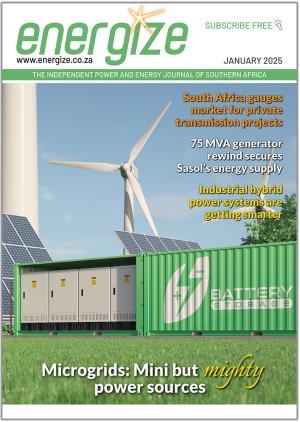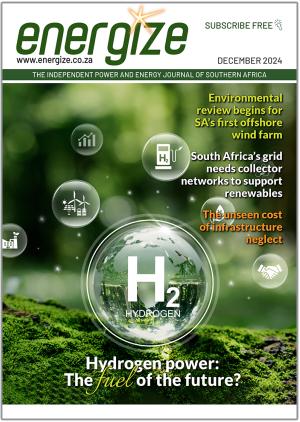by Linsey Dyer, 6th Wave Africa, and Chris Yelland, EE Business Intelligence.
Private sector businesses recently shared how their own journeys to net-zero carbon emissions took them on unexpected paths which help them not only to reach their own environmental, social and governance (ESG) goals, but also help South Africa and other customers in addressing the current electricity crisis.
These companies are taking advantage of impending changes to the structure and legislation regulating South Africa’s electricity supply industry (ESI), as the country moves toward a more open, diversified and competitive electricity generation sector, a state-owned independent transmission system operator (ISO), and an independent electricity market operator (IMO).
Limitations of previous arrangements
In the past, the South African ESI operated essentially under a “single buyer” model. In this arrangement, Eskom (the single buyer) generated electricity itself for supply to customers across the country, and also contracted to procure electricity from neighbouring countries and independent power producers (IPPs) to supplement its own generation capacity.
While the reliability, performance and availability of both the ageing and new Eskom coal-fired power stations has deteriorated sharply over the last decade, the regulatory, planning and procurement processes under the single buyer model have proved to be slow, cumbersome and bureaucratic. Eskom and the IPP Office of the Department of Mineral Resources and Energy (DMRE) have singularly failed to build or contract new generation capacity in a timely manner. As a result, South Africa has experienced high levels of load shedding over the last few years.
In line with the impending structural, regulatory and market reform to manage and address these risks, the single buyer model has been moving in an evolutionary way to include traditional one-to-one wheeling of power, contracted by large customers (the offtakers) from IPPs (independent power producers, the generators), while paying the grid operator (Eskom) a use-of-system or wheeling fee.
Traditional wheeling has essentially been limited to large, energy-intensive, industrial and mining offtakers connected to the Eskom grid, who contract with IPPs for the supply of renewable energy on long-term power purchase agreements (PPAs). Grid access constraints and the long-term nature of the PPAs have significantly delayed and limited the uptake of new generation capacity in traditional, one-to-one wheeling arrangements.
While traditional wheeling of electrical energy has been further evolving to include many-to-one, and one-to-many wheeling arrangements, with offtakers generally in a single corporate group structure, the same limitations of one-to-one wheeling in these broadened arrangements largely continue to inhibit the uptake of new generation capacity.
The emergence of third-party electricity traders
To address these limitations, the regulatory processes in South Africa have adapted to recognise the value-adding role of private-sector, third-party, electricity traders, that must be registered with and obtain a trading licence from the National Energy Regulator of South Africa (NERSA).
Third-party electricity traders generally contract renewable energy from one or more generators to supply electricity to a diversified portfolio of offtakers that may be include group(s) of companies within a corporate structure, as well as individual independent companies, with Eskom charging a use-of-system or wheeling fee as previous.
Electricity traders play a key supply and demand aggregation role that reduces the risk and the long PPA terms associated with traditional, one-to-one wheeling arrangements. This provides greater flexibility and customer choice, which facilitates and enables the participation of smaller, independent customers.
Again, however, as with direct wheeling, third-party electricity trading arrangements have largely been limited to customers connected to the Eskom grid, because almost all municipal electricity distributors are not able to cope with the complexity of changes to both the contractual arrangements with their customers, and with tariff, billing and metering system changes to accommodate time-of-use wheeling and trading.
The development of “virtual wheeling”
To address the above limitations, and to make traditional wheeling and third-party electricity trading more widely accessible to large, medium-size, and smaller industrial, manufacturing, and commercial enterprises, including those embedded in municipal distribution networks, Eskom, working together with private sector software platform developers, traders and offtakers is developing and piloting what has become known as “virtual wheeling”.
With virtual wheeling, the trader contracts with one or more IPPs to generate electricity into the Eskom grid at a negotiated pricing structure. The renewable energy generated by the IPP into the Eskom grid is metered, and Eskom pays the trader monthly for the renewable energy supplied by the IPP into the grid, and the trader, in turn, pays the IPP.
With virtual wheeling, a customer’s existing commercial and contractual arrangement with their electricity supplier (either Eskom Distribution or a municipality electricity distributor) does not change. The customer continues to receive and to pay the monthly electricity bill from its electricity supplier as usual. However, the customer additionally contracts some or all of its renewable energy needs from an electricity trader under a PPA for lower-cost renewable energy compared to that supplied by the electricity distributor.
Under the virtual wheeling mechanism, after paying for the electricity supplied and metered exactly as usual by the electricity supplier, the customer in due course receives a rebate from the trader based on that portion of lower-cost renewable energy contracted with the trader. This is a data-based financial reconciliation and settlement mechanism enabled by the aggregation power of the virtual wheeling platform.
The innovators and their journeys
Existing and emerging electricity traders and platforms include those of early pioneers such as PowerX; corporate traders initially established to serve their own corporate groups such as Remgro’s Energy Exchange of Southern Africa, Old Mutual’s NOA Group, Shoprite’s Independent Energy Pool, and Anglo American and EDF’s Envusa Energy; regional electricity traders such as Africa GreenCo; and others such as Enpower Trading, Etana Energy and Apollo Africa. In general, electricity traders have needed strong backing from financial institutions with deep pockets to deal with the trading, timing and settlement risks involved.
Furthermore, two specific examples have been in the media recently of companies that are playing a significant catalytic and formative role in the evolution of the virtual wheeling and trading environment in South Africa, namely the Vodacom and Discovery Groups.
Vodacom, one of South Africa’s leading, wireless voice and data network providers, has facilities including some 15 000 cellular network towers around South Africa. The company needs to be supplied with renewable energy to reduce its carbon footprint and hedge at least part of its electricity costs from the ever-increasing price of electricity from Eskom and municipal electricity distributors.
Vodacom understood early in its journey to net-zero that it was not possible to meet its ambition of sourcing 100% of its energy from renewable energy rather through self-generation at its facilities. Vodacom’s energy-hungry access networks, technology centres and properties represent 73%, 23% and 4% of its energy consumption respectively.
Most of Vodacom’s sites are embedded within about 180 municipal electricity supply networks throughout South Africa, with limited ground and rooftop space for self-generation by solar PV and battery storage. This made self-generation, traditional wheeling and trading arrangements impossible. Vodacom therefore needed to take a different approach to reach its ESG targets.
Similarly, several years ago, Discovery, a leading financial services organisation, also realised it was not going to reach its net-zero goal by 2030 by installing embedded generation on its campuses. Discovery understood that only 8% of its greenhouse gas (GHG) emissions were so-called Scope 1 emissions (i.e., emanating from its own operations), while 92% derived off-site from its Scope 2 emissions from consumption of Eskom coal-fired electricity. Discovery found that many other corporates were in a similar position, with average Scope 2 emissions per corporate exceeding 350 000 tonnes per annum.
Furthermore, Discovery realised that if it could address its own electricity cost containment and ESG needs through innovative renewable energy supply arrangements, it could also provide similar green energy supply solutions for customers with whom it had deep, existing business relationships through its healthcare, insurance, property, banking and other financial services.
To address its own challenge, Vodacom, in association with Eskom and Mezzanine (a Vodacom business solutions and software platform developer), co-created a “virtual wheeling” platform – a digital tool to collect, aggregate, account, process and report data for time-of-use (TOU) electrical energy generation and consumption. The framework and platform developed would also be usable by other traders and suppliers.
Discovery was quick to realise the opportunity that the virtual wheeling framework provided in addressing not only its own ESG needs, but also those of its corporate customers. To achieve this, Discovery Green was launched as an enabling technology, technical and actuarial platform that would use the virtual wheeling framework.
Discovery Green’s value proposition is five-fold: the offering would be affordable, renewable, price certain, supporting the national shortfall, and with seamless customer onboarding (in contrast to the unwieldly, protracted negotiations often required for traditional PPAs).
This virtual wheeling framework and platform developed addresses some of the key constraints of traditional wheeling, such as its non-suitability for “smaller” customers supplied at low voltage and embedded within municipal networks – which includes most business and residential customers in South Africa.
Another benefit is that, unlike traditional electricity wheeling and trading arrangements, the virtual wheeling framework does not require any amendments to existing electricity supply contracts with the municipal distributor, or changes to the municipal tariffs, metering and billing systems.
Initial piloting of the virtual wheeling framework is underway by Eskom. In addition, further refinements are being considered to reduce the trading, timing and settlement risks, the risk of Eskom payment default, and the risk of deterioration in the financial status of municipalities in good standing with Eskom.
However, despite this further work, virtual wheeling shows great promise in expanding access by customers to renewable energy, reducing their carbon footprint, containing and reducing their electricity cost increases, and bringing new, clean generation capacity to the grid.
Who benefits besides large corporates?
Virtual wheeling opens the door to electricity supply choice, reduced electricity costs and retail competition, not only for large corporates, but ultimately also for small, medium and micro enterprises (SMMEs) and residential customers in municipalities in good standing with Eskom.
Smaller businesses in South Africa contribute significantly to the economy, accounting for some 46% of all waged employment in the first quarter of 2021; the informal sector for another 13% in the same period; while formal small and medium enterprises outside of agriculture contributed an important 38% of GDP.
Eskom benefits by increasing its supply of low carbon electricity relatively quickly to supplement its own sources of generation and fill the gap at little or no capital cost, thus also reducing its usage of high-cost emergency, diesel-powered, open-cycle gas turbines (OCGTs).
Municipalities benefit by maintaining and growing their existing electricity supply arrangements without reducing or compromising their electricity supply revenue streams. Municipalities rely on these revenues for their sustainability, and since municipalities cross-subsidise other services with these revenues, this represents a critical requirement in continued service delivery across the country.
Virtual wheeling incentivises municipalities to pay their arrear debt to Eskom to benefit from the access that customers embedded in municipal networks will have to the arrangement. This in turn incentivises customers supplied by municipal electricity distributors to pay their electricity bills to benefit from the green credentials available to them.
By leveraging the power of markets, innovating private sector companies are driving fairer and more inclusive solutions which will benefit all energy stakeholders – Eskom, IPPs, traders, business, municipalities, and their “smaller” electricity customers.
Ultimately, everyone in South Africa benefits from a more open, diversified and competitive electricity generation sector that increases electricity supply and reduces load shedding.
Send your comments to rogerl@nowmedia.co.za















